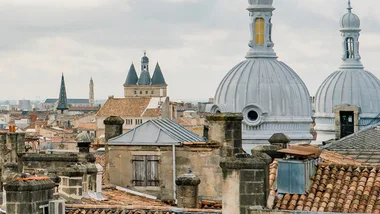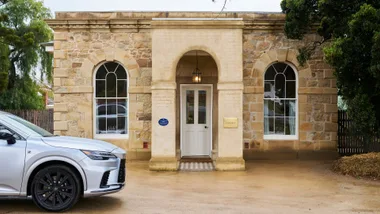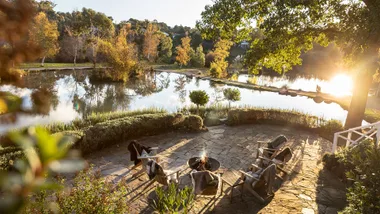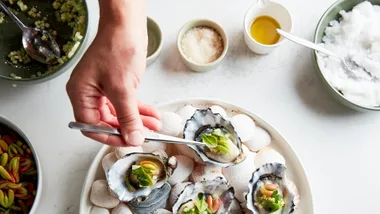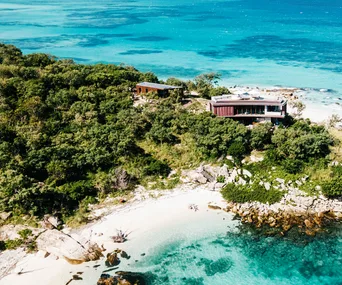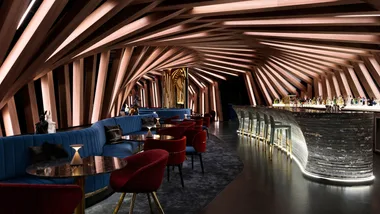THE FINE PRINT
**GETTING THERE
**By air: British Airways operates flights twice daily from Sydney to London via Bangkok or Singapore with onward connections to Genoa and Nice. 1300 767 177.
By land: From Nice, take the A8 La Provencale Autoroute to the Italian border, then continue along the A10 Autostrada dei Fiori, before turning off at your chosen exit. From Genoa, take the A10 in the direction of Savona-Ventimiglia; from Savona southwards you’re on the Riviera di Ponente. Trains run frequently in both directions; try Trenitalia.
**STAY
**[Bellavista
](http://www.bellavistacervo.com)Recently refurbished family-run hotel. All rooms enjoy a breathtaking view over the town below and the Gulf of Diano beyond. Includes a restaurant serving home cooking. Castello 2, Cervo, Imperia, +39 0183 408 094.
[Ca’ del Vescovo
](http://www.cadelvescovo.it)Elegant B & B apartment situated in the lively old quarters of Imperia. Via Giosuè Carducci 7, Porto Maurizio, Imperia, +39 3385 977 113.
[I Freschi
](http://www.ifreschi.com)Just 4km from the beach, beautifully furnished apartments in the converted farm cottages of an old country hamlet. Breakfast hamper included. Via Luvea 14 bis, Borgata Freschi, San Bartolomeo al Mare, Imperia, +39 0183 406 868.
[Le Raganelle
](http://www.leraganelle.net)Farm set among orchards and olive groves just 1500 metres from the sea. Beautifully converted rooms and apartments complete with antique furniture and ornaments. A restaurant serves dishes made with the farm’s organic produce. Via Case Sparse reg. San Siro, Diano Castello, Imperia, +39 0183 401041.
**
EAT
**[Da Casetta
](http://www.dacasetta.playrestaurant.tv)Ligurian cooking at its best in a homely atmosphere: stuffed vegetables, vegetable pies, ravioli filled with asparagus or artichoke, stewed snails, rabbit with olives. Via XX Settembre 12, Borgio Verezzi, Savona, +39 019 610 166.
**Da Pino
**Super-fresh fish bang on the seafront in one of the prettiest towns on the Riviera. Don’t miss the cold and warm antipasti: carpaccio of cuttlefish with celery; anchovies with chilli; baby octopus with cep mushrooms. Corso Italia 23, Noli, Savona, +39 0197 490 065.
[Ristorante Didù
](http://www.ristorantedidu.it)Small, friendly restaurant run by the ebullient Gianna Greco in the centre of town. Look out for Slow Food Presidia products such as Albenga violet asparagus and Vessalico garlic. Viale Matteotti 76, Imperia,+39 0183 273 636.
**La Campagnola
**This small informal trattoria up in the hills above the Gulf of Diano is run by husband and wife team Aldo and Gina Bracco. They make everything themselves: vegetable fritters, stuffed zucchini flowers, tagliatelle, ravioli, rabbit with olives. Though you can see the sea below, theirs is strictly country cooking. Via Piave 8, Tovo Faraldi, Imperia, +39 0183 410 31.
[Paolo & Barbara
](http://www.paolobarbara.it)The finest restaurant in Liguria, according to many reliable Italian guides. Traditional fish dishes interpreted with consummate style and flair. Menus based on the catch of the day. Via Roma 47, Sanremo, Imperia, +39 0184 531 653.
Fine Ligurian cooking of land and sea: mullet with fresh tomato, spring onions and bottarga; spaghetti with shrimps and artichokes; calamari with garlic, rosemary and potatoes. The restaurant is housed in a converted medieval building and has a scenic terrace, a bar, a shop and limited accommodation. Via A Volta 19, Cervo, Imperia, +39 0183 400 175.
**FURTHER INFORMATION
On holiday in the north-western Italian region of Liguria over the winter of 1903, the English composer Edward Elgar conceived a concert overture. It was, he wrote in the epigraph to the score, an attempt to capture “the thoughts and sensations of one beautiful afternoon in the vale of Andora”. As the sunlight danced around him and flickered among the olive groves, he looked up the valley and addressed it directly: “thou art the garden of the world” were his words. He named his overture In The South (Alassio) after the place in which he was staying.
If Elgar were around today, he would find that the rugged, mountainous landscape of Liguria’s inland valleys has remained majestically and colourfully intact, but he would be hard pressed to recognise the coastal strip. In his day, places like Andora and Alassio were no more than small fishing villages. Now they are two of a long sequence of seaside resorts that runs south-westwards from Genoa to Ventimiglia to form the Riviera di Ponente, or Western Riviera.
The first section runs to Imperia and goes under the name of Riviera delle Palme on account of its abundance of palm trees; the second is the Riviera dei Fiori, flowers being one of the area’s main exports. The centre of the flower industry is Sanremo, one of whose famous residents was Alfred Nobel, the inventor of dynamite (which he used to test from his private jetty) and the founder of the prize that takes his name. The city has sent flowers to Stockholm for the Nobel Prize ceremony since it was held for the first time in 1901.
The natural beauty of the Riviera has always exerted a strong appeal on artists – the French Impressionists Monet and Renoir enjoyed painting in Bordighera and Dolceacqua – but it was Elgar’s compatriots, the Brits, who first grasped its potential as a holiday destination. Attracted by the mild climate, clean air and breathtaking scenery, they flocked here from the 1880s onwards, establishing colonies in Sanremo, Bordighera and Alassio. Traces of their passing are everywhere to be seen. One such is the Hanbury Botanic Gardens on a cliff overlooking the sea at La Mortola, close to the French border, founded in 1867 by Sir Thomas Hanbury and home to a stunning collection of some 5000 exotic plants from all over the world, including an “Australian forest” with eucalyptuses reaching up to 30 metres in height. The eucalyptus was introduced to Liguria in the late 18th century and is cultivated by the flower industry for the decorative qualities of its branches. On the Riviera, anything grows.
In the early 1920s and ’30s, the grand hotels on the coast became a regular holiday destination for well-to-do Italians, and after World War II, thanks to its casinos, clubs and café society, the coast was a favourite haunt of the international jet set. Sanremo’s Song Festival, one of Italy’s most important music events, made its debut in 1951. In the same period, the Caffè Roma roof garden in Alassio attracted big names from the worlds of culture and showbiz. One day, Caffè Roma’s owner, painter Mario Berrino, decided to ask celebrities passing through the area to sign coloured tiles and to display them on a stone wall outside the establishment. Holidaying in Alassio in the early 1950s, Ernest Hemingway was the first to comply. The wall, known as Il Muretto, is now smothered with these autographed tiles and has become a tourist attraction in its own right. Many of the 500 or so names – of singers and sportspersons, of artists and actors – will mean little to non-Italians, but there’s also a fair number of international names, including that of Rolf Harris.
In the 1950s and ’60s, the years of Italy’s postwar economic boom, the Riviera di Ponente became the holiday playground for families from northern Italy’s industrial triangle of Turin, Milan and Genoa. People had money to spend, time to spare, and sun, sand and sea at their own back door. With the advent of cheap overseas travel, the Riviera today is less hectic than it used to be, but it still makes an ideal holiday. Maybe not as stylish as the Côte d’Azur over the border, nor as swanky as the Riviera di Levante to the east of Genoa, where society resorts such as Rapallo and Portofino cater strictly for the super-rich, it nonetheless possesses a homely charm all of its own.
The area has been inhabited since the Stone Age; bones of Homo erectus and Cro-Magnon have been found by archaeologists in the Balzi Rossi caves near Ventimiglia. The city of Ventimiglia itself has a Roman theatre dating from the second century, Albenga is home to a unique fifth-century palaeo-Christian baptistry, and in Noli, just 100 metres from the beach, sits the splendid 11th-century Romanesque church of San Paragorio. Later styles of architecture, from Renaissance to baroque to neoclassical, can be admired in forts and castles and churches and abbeys in virtually any of the Riviera’s seaside towns and inland villages. To think that most holiday makers don’t even know these treasures exist.
Every summer for the past 20 years I’ve rented a cottage at the end of an old mule-track up in the hills in the province of Imperia. After the rigours of the long winter in Piedmont where I live, trips to the Riviera are restorative for body and soul. During the drive down to the cottage, the scenery changes dramatically. From one hairpin bend to the next, an Alpine landscape suddenly turns into a Mediterranean seascape. Firs and pines are replaced by olive trees and palms, glints of blue appear in the distance, and the dank odour of damp undergrowth gives way to the fresh scents of citrus fruit and wild herbs. This is one of those rare spots on the planet where, at certain times of the year and weather permitting, it’s possible to bathe in the sea and ski in the mountains on the same day.
My cottage looks out over the Golfo Dianese, the Gulf of Diano, hemmed in between Capo Cervo to the east and Capo Berta to the west. I may be biased, but to my mind this is one of the loveliest gulfs in Liguria, if not in Italy. There are certainly few to beat it along the 800km of coastline from here to the Bay of Naples. Nestling at its centre is the beach resort of Diano Marina: the place is mostly modern, having been rebuilt after the disastrous earthquake that hit Liguria in 1887. Inland is a cluster of many other “Dianos” – Diano Arentino, Diano Castello, Diano San Pietro, Diano Borganzo, Diano Roncagli and others besides, all with well-kept cultural and gastronomic secrets. Diano Castello, atop a hill a couple of kilometres from the sea, was the medieval “capital” of the area and has cobbled lanes lined with old patrician residences and as many as five churches, a lot for such a small place. One of them, the Oratorio di San Bernardino e Santa Croce, houses delightful 15th-century frescoes by two Piedmontese painters, the Fratelli Bisacci. In the shadow of Diano Castello, Diano San Pietro is home to a rare fortified church, built in the 17th century to protect the locals from Saracen raids.
The name “Diano” derives from Diana, the Roman goddess of hunting. It’s hard to credit nowadays, but in ancient times the whole area was covered with woodland. Moving from hunter to prey, we come to the pretty village of Cervo (which means stag in Italian), a maze of narrow lanes and alleyways that dominates the gulf to the east. From a distance, the pastel-coloured stucco façade of its Chiesa dei Corallini, the Church of the Coral Fishermen, looks more like the handiwork of a mad pastry chef than a piece of sacred art.
The inland valleys of the gulf were the first in Liguria to cultivate the olive, now one of the region’s prime agricultural products. When the small Taggiasca variety was introduced in the 15th century, cereal mills were converted to olive presses and the oil industry boomed. Naturally enough, extra-virgin olive oil is the leitmotiv of the local cuisine, adding zest to dishes assembled with the simplest ingredients.
Ligurian cuisine corresponds perfectly to what is defined these days as the “Mediterranean diet”. Pine nuts, walnuts and mushrooms are commonly used, and given the exceptional microclimate, the area produces an array of juicy, pulpy vegetables. Some of the latter are Slow Food Presidia, projects designed to save and protect rare foods, each named after its place of origin: the Albenga violet asparagus, the Pigna bean, Vessalico garlic, the Perinaldo artichoke.
After centuries of poverty, Ligurians have learned to use aromatic herbs – marjoram, basil, borage, thyme and sage – in the most ingenious ways. The oil-herb-vegetable combination appears as a filling in stuffed pastas, in soups, and in dishes such as condijun (a mixed salad enriched with tuna) and frisceu (fritters). Pesto, the classic basil and garlic emulsion, goes well with all the local pasta shapes, from corzetti to trofie to trenette. Ligurians set great store by their pasta: they have a saying, “O l’è stato battezzou in te l’aegoa di ravieu!” Literally translated, it means “He was christened with the water from the ravioli,” but the sense it conveys corresponds to the English “He was born with a silver spoon in his mouth.” Pasta apart, other farinaceous favourites are focaccia, torta verde (a savoury pie of spinach or silverbeet or zucchini or artichokes, sometimes with the addition of rice), farinata and panissa (baked chickpea flour batter), and piscialandrea, the Ligurian pizza named after the Genoese admiral Andrea Doria, served with a variety of toppings from anchovies and tomato to sardines and olive oil.
Mainly as a result of the lack of space between sea and mountains, there’s no great tradition of livestock breeding along the Riviera. On menus, beef is conspicuous by its absence, and meat usually comes in the form of home-raised rabbit or chicken. As to fish, the Mar Ligure, the Ligurian Sea, has never enjoyed particularly abundant stocks. There’s no shortage of seafood restaurants on the coast, but it is significant that, after the versatile anchovy and sardine – both fryable, grillable, stuffable and conservable – the fish that figures most frequently in local recipes is an outsider: cod, more often than not in its dried, salted form as baccalà, or stoccafisso. Ciuppin, the Riviera’s own fish soup, similar to Provence’s soupe de poisson, is normally made with mullet and simply anointed with the best extra-virgin olive oil. And any fish preparation described as “Alla ligure” involves baking with potatoes, olives and herbs.
Where there’s food there’s wine, and along the Riviera, on or near the coast, they produce a white, vermentino, and a red, Rossese di Dolceacqua, of considerable prestige. The first was once described by a local oenologist, a certain Zaccone, as “the only white wine in the world worth drinking with oysters”. He was probably under the influence of too much vermentino when he said that. He would have been more accurate if he’d argued that the wine is perfect as an aperitivo and with most of the local dishes mentioned above. Rossese enchanted Napoleon when he passed through the region on his Italian campaign in the late 18th century, and in 1972 it became the first Ligurian wine to qualify for DOC status. It is an ideal accompaniment to inland meat and game specialities.
The Italian collective consciousness perceives the Riviera di Ponente as just a long strip of bathing establishments and sun umbrellas. And while historically, culturally and gastronomically it is, it offers more than that. Much more. Sometimes it takes an outsider to appreciate the appeal of a place.
 Lucas Allen
Lucas Allen
